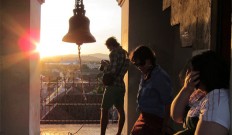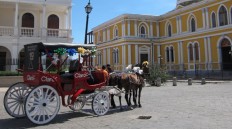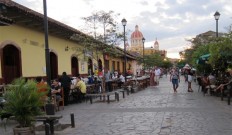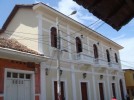Granada’s unique charm owes much to the city’s uncanny ability to hang on to its colonial beauty while its neighbors to the north—especially Managua, but even Masaya and Leon—have suffered the devastating effects of the earthquakes, hurricanes, and fires that are about as common in Nicaragua as lakes and volcanoes. This fact isn’t lost on city officials. If the conservative Granadan government is divided over the desirability of gringos in their town, at least they’re in accord over the preservation of its rich architectural heritage. If you’re considering purchasing a home for personal or investment purposes, you’d better be familiar with the ins-and-outs of local home renovation.
Luckily, the legal requirements for remodeling a colonial—being more concerned with visual aesthetics than safety—are pretty straightforward. If you own a colonial home, you cannot structurally alter the façade. You can repair and paint the exterior, but you can’t add windows or doors, for example. And you can re-roof but you have to use the same kind of roofing tile. Everybody knows the first rule of real estate: location, location, location. In Granada, it’s location, location, façade.
How do you know if the restriction applies to the home you have designs on? Over the years, hard economic times have forced residents to subdivide their homes as the extended family grows. The house you are thinking of improving may actually be a half-colonial. But what constitutes a colonial house is not the size or even when it was built. The alcaldia (the mayor’s municipal office) has designated a well-defined area in the center of town as the colonial district. There’s a map in the office marking the boundaries and the line zigzags up one street and over another, so you’ll have to stop by to see if your house is subject to the building codes.
If you’re still in the market for a home, buying outside of that 2-3 block radius around Parque Central will not only give you a little more flexibility in terms of remodeling options, but the prices will be a little better as well. But whether you’re looking in the historic center of town or farther out, you may have trouble finding something. The Nicaraguan people are tight-knit and proud. Houses stay in the family for generations not only because married children often stay, but also because selling the house risks creating a perception among neighbors that they’re losing financial clout. Chances are they won’t put a sign up.
Start with the real estate agents in town; they’ll probably know a number of otherwise unadvertised offerings. If that fails to unearth your diamond in the rough, put word out among the locals. You never know what might turn up. Be aware, however, that inside information isn’t necessarily free. Some Nicas build up a network of contacts to gather such information and they will expect a commission. Another option still—one resorted to by more than one ex-pat in town—is walking down the street and knocking on doors.
Once you’ve got your raw material, you’ll need to decide what, exactly, to do with it. Everything behind the façade is pretty much fair game and depending on your expectations for the finished home, often everything from the façade back has to be ripped out.
A colonial home and a colonial-style home are two different things. This is a crucial distinction. In a true colonial home, for example, only the hired help spent time in the kitchen, so the kitchen was in the back to keep the servants from overhearing family business and gossiping. In modern Western culture in which people enjoy cooking and entertaining, the kitchen has become one of the centers of activity in a home. But traditions die hard, and Nicaraguan architects today still design kitchens away from the rest of the house, with little attention paid to aesthetics and usability. If your lifestyle requires a new floor plan, you will only actually be remodeling the street-facing wall(s). Everything else will be new construction. And, the building codes for new construction are as simple, if less demanding, than those for remodeling.
“It’s so easy to build beyond the codes that most people just use common sense,” says John-Marc Gallagher of Granada Property services. He and his wife Janice have been involved in a number of renovation projects both here and in Costa Rica and are currently re-doing a house on Calle Santa Lucia. For Gallagher, the North American construction standards he’s accustomed to are more than adequate to pass muster with the building inspectors. For example, Granada has only recently required septic-tank disposal for gray water, but for most foreigners that’s already de rigueur.
There are construction practices indigenous to the area that may not exist back home, however, that should be followed. These are the practices developed not to protect the façade, but the structure itself from the harsh Nica Mother Nature. Regardless of what the codes require, you’ll want to protect your loved ones and your investment from earthquakes, so be sure that your plans include seismic protection. Also, if rainwater is not kept off adobe, it will collapse—just ask the people at La Gran Francia—and there are tricks to keeping roofing tiles from shifting and exposing the house to leaks. For local particulars such as these, finding a good architect and foreman is perhaps more important that scouring the published building codes.
Ask around and get recommendations before selecting an architect. You’ll want someone who is accessible and who is as invested in seeing your vision executed as you are. Plans may cost in the neighborhood of $300 and the turn-around time can be as little as a week.
If you plan to run a dishwasher, dryer, and large air-conditioning unit at the same time and want 220 volts instead of the standard 110 to handle it, you must take your plans to the fire station (located on the corner of Calle Corrales and Calle de 14 de Septiembre) so that the bomberos can make sure your wiring is adequate. Do this before you take your plans to the alcaldia. It should run 3-400C$ and will take about a day. Later, when you’re ready to turn on the electricity, you’ll have to take your fire-department-stamped papers to the energy company and request the extra power load.
Once the plans are ready, you will need to submit them to the city architect and civil engineer for review. (The alcaldia is located at the S.E. corner of Parque Central.) Reportedly, the Spanish government, through the Co-operation Española, has a say in what is acceptable in restoration efforts of colonial homes–after all Granada’s colonial history is also Spain’s colonial history. The city will run your plans by the co-operation in the review process.
Be warned, the hoops may seem arbitrary and highly subjective. Gallagher had to add a window to a bathroom so that there would be ambient light should the power go out as it often does here—of course, that only works in the daytime, but that’s what the city wanted.
People have been able to squeak exceptions by but don’t count on being able to do that; there’s usually little room for argument. And don’t try to influence their decision with under-the-table payments. The alcaldia may have accepted your money in days gone by, but these days everything is by the book. The best you can do is send in your architect and let him negotiate the best compromise he can. Generally the process takes 1 to 3 months.
David Dell, who is finishing a house near Iglesia Guadalupe, recommends taking a rough sketch in first to get the alcaldia to approve the concept. He takes photos and superimposes the changes on them and takes that in for preliminary approval. When they give a verbal go-ahead, take the sketch to the architect. It will save a lot of time and money in rounds of changes with the architect.
Once the plans are signed-off, the city will issue a building permit, the cost of which is based on the square footage of the new structure. This could run from a couple to several hundred dollars. Once it’s yours, laminate it and tack it up on the worksite like a trophy where everyone can see. In addition to showing off your ability to navigate the system, it will keep the building inspector from issuing a stop-work order, should he decide to pay a visit.

 Amazing photo opportunity
Amazing photo opportunity Eat Vigoron at the Central Park
Eat Vigoron at the Central Park Take a horse carriage ride through Granada
Take a horse carriage ride through Granada




